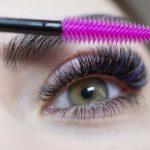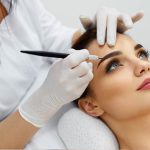There's More to MASCARA than Meets the Eye
Get outta here! How to remove make-up properly?

Eye skin area constitutes the most delicate and the thinnest part of face. It’s because this skin area in particular is entirely devoid of fatty tissue. Thus, eye skin is the fastest to be badly affected by the ageing processes. In order to slow them down, a greater attention must be paid to conditioning the very face part, especially while removing make-up. How to remove make-up properly step by step and what are the most common mistakes made during this procedure?
How to remove make-up properly?
- Preparations for eye make-up removal has to begin with precise hand washing. Touching face skin with dirty hands contributes to infections, e.g. conjunctivitis.
- The proper eye make-up removal implies soaking two cotton pads with a preparation that matches a particular skin type. It’s also worth paying attention to the amount of the cosmetic distributed; it has to be optimal. If there is too much of it, you may expect it to get into your eyeballs and, as a result, trigger irritations. On the other hand, if there is too little of it, removing make-up might appear to be a very tough and time-consuming process, sometimes even impossible.
- After that, the cotton pads have to be gently pressed to closed eyelids. You have to give the preparation some time to start removing make-up. Thanks to this, neither rubbing nor stretching eye skin area will be necessary, especially that the very action is ineffective and damaging. Why? Because it leads to mechanical damages of lashes and encourages wrinkles.
- Mascara has to be removed by applying delicate up-and-down motions. In this way, the risk of lash damages will be reduced.
- Next, by using very delicate motions, heading from outer to inner corner of an eye, remove the make-up residues.
- If the cotton pad is still dirty, you must replace it with a new one. In general, for eye make-up removal you will need more or less 4-5 cotton pads. Keep replacing them until the last cotton pad remains clean.
Eye make-up removal and cleaning eye skin area depends on taking colour cosmetics off from upper and lower eyelids as well as eyelashes and eyebrows. Frequently, eyebrows are neglected at this stage.
Eye make-up removal: The common mistakes
1. Ill-matched make-up removers
Make-up removing cosmetic must be well-selected, and this means that they should neither contain paraffin nor alcohol, especially if the products are supposed to remove colour cosmetics from sensitive skin. A micellar lotion seems to be a good solution for all allergy sufferers. This product is delicate and versatile, it doesn’t only remove make-up but also leaves skin clean as a toner does.
Most make-up removers contain additional substances which aim is to boost the effectiveness of it, yet they don’t always work in favour of skin. For that reason, it’s better to choose cosmetics which list of ingredients is short and simple. Hence, even a coconut oil turns out to be a better solution than popular face cleaning gels. Besides, products designed for sensitive skin types are recognized as not effective enough. They don’t take off the colour cosmetics too precisely, thus the mascara smudges.
2. Rushing while removing make-up
We often take make-up off fast and not necessarily in a precise way. We do it mainly because in the evening we are tried after the entire day of work and simply we don’t feel like spending more time on doing anything but taking a rest. Nevertheless, make-up removal requires time because if you want to make it effective, you must allow the removing preparations work and melt the colour cosmetics, especially the waterproof mascara.
3. Too fierce rubbing
Intensive rubbing of eye skin area is neither effective not safe since it causes irritations, eye infections, and in the case of couperose skin type – broken capillaries. This kind of make-up removal weakens and pulls out lashes and brows, sometimes it can even lead to hair discolorations.
It’s worth realising that the formula of most make-up removing products is composed in such a way to enable easy use. This means that all that has to be done is pressing a damp cotton pad to a selected skin area. It’s also worth reaching for Q-tips while taking off make-up. This accessory deals with removing make-up residues better than its bigger equivalent – a cotton pad.
4. Lack of hygiene during make-up removal
We frequently don’t follow the basic rules of hygiene while taking off colour cosmetics from our faces. Namely, we remove make-up with our dirty hands and repeatedly use the same cotton pads. Therefore, it must be realized that both dirty hands and dirty cotton pads are the habitants of bacteria which encourage pimples.
5. The right order of removing cosmetics
Many women believe that the order in which colour cosmetics are removed doesn’t have any vital importance. It appears that this conviction isn’t true. Make-up removal has to begin with taking lipstick off. Then, we can proceed with removing mascara, eye shadows and eyeliner. The last step is freeing face from foundation and washing it with gel or foam.


